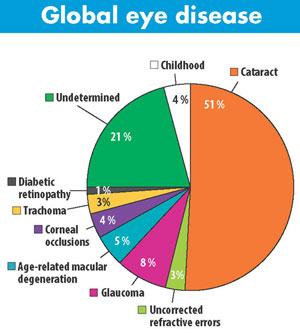The National Eye Institute (NEI): Battling global blindness, eye disease through research
November / December 2012 | Volume 11, Issue 6
Blindness is tragic wherever it strikes. For many in the developing world, it condemns them to a life of poverty with little chance to live independently. As much as 90 percent of the global burden of eye disease is shouldered by developing countries, where treatable diseases often go undiagnosed. About 39 million people around the world are blind and a further 246 million are unable to see properly, according to the WHO.

Photo by Ray Witlin/World Bank
About 39 million people in the world are
blind, yet 80 percent of blindness is
considered preventable. The National Eye
Institute at NIH supports research into eye
diseases that hit the world’s poor the
hardest, including trachoma, cataracts and
other conditions.
To help combat visual impairment and eye disease globally, as well as in the U.S., the
National Eye Institute (NEI) at the NIH supports a wide range of research studies. The NEI recently developed a new strategic plan to guide its activities in international research and global health. Its goals include establishing a full-time office devoted to the issue, fostering a sustainable research environment globally, expanding collaborations to advance vision research and supporting partnerships that add scientific value to NEI programs. In addition, the NEI intends to develop scientific capacity in the U.S. through training and mentoring to meet global health challenges and support vision research in the future.
NEI currently funds more than two dozen grants at 36 foreign sites in 15 countries. A number of these research projects focus on eye diseases prevalent in low-resource settings such as trachoma in Ethiopia and Tanzania, glaucoma in Ghana and corneal ulcers in India. Meanwhile, scientific collaborations in developed countries are probing a wide range of specialties from retinal stem cells in Canada, to diabetic retinopathy in Denmark, to pediatric eye disorders in the U.K.

Pie chart of global eye disease
- Cataract - 51%
- Undetermined - 21%
- Glaucoma - 8%
- Age-related macular degeneration - 5%
- Childhood - 4%
- Corneal occlusions - 4%
- Trachoma - 3%
- Uncorrected refractive errors - 3%
- Diabetic retinopathy - 1%
Source: The World Health Organization (WHO)
Global data on visual impairment 2010 [PDF, <1M]
In addition, the NEI has been collaborating with the WHO since 1979 to build research capacity by pairing experienced investigators with local scientists to study an eye health problem in that country. This collaboration has produced some 30 scientific publications about topics such as visual impairment in school-age children in developing countries and the evaluation of eye care services and the burden of poor vision and blindness in Brazil.
About the National Eye Institute
The National Eye Institute, one of the 27 institutes and centers that make of the NIH. Its director is Dr. Paul A. Sieving. It has the mission to conduct and support research, training, health information dissemination and other programs with respect to blinding eye diseases, visual disorders, mechanisms of visual function, preservation of sight and the special health problems and requirements of the blind.
Established by Congress in 1968, the NEI supports and conducts research that leads to sight-saving treatments, reduces visual impairment and blindness, and improves the quality of life for people of all ages. NEI-supported research has advanced knowledge of how the visual system functions in health and disease.
NEI supports approximately 1,600 research grants and training awards made to scientists at more than 250 medical centers, hospitals, universities and other institutions across the country and around the world. The NEI also conducts laboratory and patient-oriented research at its own facilities located on the NIH campus in Bethesda, Maryland.
More Information
Articles in the Focus on the National Eye Institute at NIH section were produced by Cathy Kristiansen, with contributions from Christopher G. Thomas, Tom Hoglund and Richard S. Fisher.
To view Adobe PDF files,
download current, free accessible plug-ins from Adobe's website.